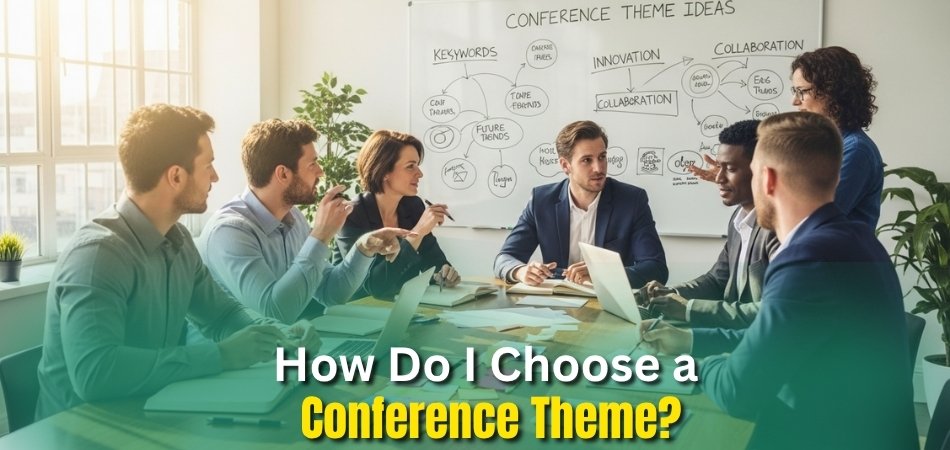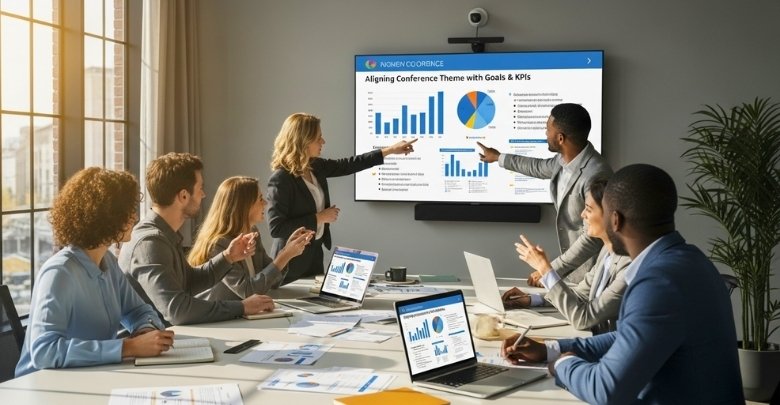Picture a conference where every detail flows together: the venue, the sessions, the networking opportunities, all anchored by a theme that resonates with attendees. A strong theme sets the tone, builds interest, and guides the entire event’s atmosphere. Without it, even the best content may feel scattered or disconnected. If you are wondering, “How do I choose a conference theme?”
To choose a conference theme, first think about who will attend and what they care about. Make sure the theme matches the event’s goal, like learning or sharing ideas. Use current topics, ask others for ideas, and check if the theme is clear, simple, and fits your event plan.
Follow along as we dive deeper into actionable tips to help you choose the perfect theme.
How Do I Choose a Conference Theme?
Picking the right theme for your event shapes the mood, focus, and impact. It guides the speakers, sessions, and conversations. With careful thought, you can create an idea that attracts people and inspires them throughout the program. Here are key steps to help you choose one effectively.

Step 1: Understand Your Audience
- Every group has unique hopes, challenges, and goals, so understanding these helps build a theme that excites them.
- Audience-driven themes create emotional connections, leading to better participation, deeper discussions, and more valuable networking opportunities.
Step 2: Match Event Goals
- A theme should connect directly to the objectives, whether that is learning, sharing innovations, or encouraging collaboration.
- Event goals give focus and direction, ensuring that every part of the conference reinforces the same vision.
Step 3: Look at Current Trends
- Industry shifts change quickly, so including new ideas ensures the theme stays modern and sparks useful conversations.
- When a theme matches trending topics, participants feel the event is current, fresh, and worth attending.
Step 4: Work with Stakeholders
- Sponsors, organizers, and speakers bring different viewpoints, which can improve the theme and its overall relevance.
- By involving them early, you encourage support, making the planning process smoother and much more effective.
Step 5: Check Practicality
- Great themes still need to fit within budget limits, venue capacity, and time available during the event.
- Practical ideas avoid stress later, ensuring smooth delivery and a better experience for both planners and attendees.
Step 6: Define Clear Goals First
- Identifying the outcomes early helps organizers decide whether the theme supports measurable success and real value.
- This step prevents distractions, keeping the event centered on delivering strong takeaways and meaningful progress.
Step 7: Study Audience Preferences
- Audience demographics reveal what will interest different age groups, professions, and learning styles at your gathering.
- By honoring these details, the theme feels more personal and engaging for a wide range of attendees.
Step 8: Brainstorm with Creativity
- Team brainstorming sessions spark fresh angles, leading to unique themes that stand out from typical conference ideas.
- Creativity allows themes to feel bold, memorable, and aligned with the spirit of the overall event.
Step 9: Shortlist and Refine
- Sorting through ideas helps narrow the focus, making sure the final option has clarity and broad appeal.
- Refinement removes weaker choices, leaving a theme that works across sessions and creates lasting impressions.
Step 10: Think Global Relevance
- Conferences happen worldwide, from a conference in USA to events in Germany, Japan, and other major hubs.
- Choosing a theme with a global perspective attracts more interest and ensures cross-border engagement across diverse audiences.
Common Mistakes to Avoid When Selecting a Theme
Picking a theme sounds exciting, but many planners fall into avoidable traps that weaken the impact of their event. A theme should not only sound appealing but also carry meaning for the audience. When mistakes occur, participants lose interest, and the event feels less valuable. Let’s look at common errors that often happen during theme selection and how you can steer clear of them.
- Ignoring Audience: Themes that don’t match attendees’ interests make them feel disconnected, leaving sessions without real energy or strong participation.
- Overcomplicating Ideas: Complex wording confuses people, while simple and clear language helps everyone instantly understand the focus of the event.
- Forgetting Objectives: A theme unrelated to the main goals disrupts planning, making it hard to deliver consistent messages throughout the event.
- Chasing Trends: Following every new buzzword can make themes look shallow, losing long-term value when the fad quickly disappears.
- Skipping Input: Without feedback from stakeholders, themes may miss essential perspectives, creating gaps in relevance and potential planning conflicts.
- Budget Blindness: Big ideas may collapse if costs rise beyond limits, so themes must be practical within the available resources.
- Venue Mismatch: A theme suggesting something huge in scope can clash with a small venue, confusing attendees before sessions even begin.
- Too Generic: Generic themes fail to stand out, leaving attendees uninspired and forgetting the event soon after leaving.
- Lack of Flexibility: Rigid themes restrict creativity, while flexible ones allow organizers to adjust content without losing overall event consistency.
- Weak Messaging: Themes without clarity fail to communicate purpose, leaving sponsors, speakers, and attendees unsure about their role.
Checklist to Validate a Theme With Target Audience Research
Sometimes picking a theme feels exciting, but it also makes you stop and think carefully about the choices. You might feel the idea sounds great, but then wonder if people will actually connect with it. A theme only works when the audience feels interested and excited about the idea. Here are the key steps to confirm whether your chosen theme truly fits your target audience.
Know the Audience
Start by asking who is going to attend the event and what really matters to them. People want themes that speak to their challenges, goals, and everyday situations. If the theme matches their needs, they will feel more engaged. When people feel connected, they naturally enjoy and participate more in the sessions.
Match the Goals
Think about why the event is happening and what the organizers want people to learn or achieve. A theme that matches the main purpose always creates a stronger and clearer direction for everyone. It helps participants see the value in the event quickly. When the theme is tied to the goal, the event feels more complete.
Check Current Trends
Themes that link with popular or new ideas instantly create curiosity for people attending. If everyone is already talking about a trend, adding it to your theme makes it more exciting. People like discussing ideas that feel fresh and important. Staying updated ensures the event is never boring or out of place.
Ask for Input
Invite others, like organizers, speakers, or even potential attendees, to share their thoughts about the theme. Getting different ideas gives you a bigger picture of what people really want. It also makes the audience feel included in the process. When people give suggestions, they feel a sense of connection and trust.
Compare With Examples
Sometimes, looking at successful events helps you see how others connect their theme with the audience. You can check if those events worked well and why they left a strong impression. While doing this, think about what might be the best topic for a conference and how your theme relates. Comparing ideas with real examples can give clarity and confidence before making a choice.
Keep It Simple
Long or confusing themes can make people lose interest before the event even starts. Simple words that everyone understands work better and stay in memory longer. Clarity also makes it easier for speakers to follow the same focus. A simple theme keeps the energy flowing throughout the event.
Test the Idea
Before making a final call, share the theme with a small group of possible attendees. Ask if they find it interesting, useful, or relatable. Their reactions can tell you if the theme is strong or needs changes. Testing early saves time and avoids disappointment later.
How to Align a Theme With Conference Goals and KPIs?
When planning a conference, the theme acts as a guiding star for every detail. A clear theme makes sure people understand what the event stands for. Organizers often struggle when the theme does not support the main purpose. Let’s look at practical ways to align themes with actual goals and KPIs.
- Clear Objectives: Themes that highlight conference goals make every session purposeful, helping participants understand expected takeaways while organizers track success clearly.
- Measure Impact: Creating KPIs linked to themes ensures event results can be checked, making improvements easier for future planning and growth.
- Audience Focus: Themes built around attendee needs encourage stronger engagement, leading to better satisfaction scores and clearer measurable feedback for organizers afterward.
- Relevant Content: Aligning sessions with the theme keeps content consistent, supporting event goals and making evaluation of outcomes much more effective.
- Strong Messaging: Consistent communication across materials reinforces KPIs, ensuring attendees stay aware of the conference’s focus before, during, and after.
- Feedback Loop: Asking for audience input checks whether the theme aligns with goals, offering insight into KPI performance and future improvements.
- Practical Planning: Themes designed within event limits support realistic KPI achievement, balancing creative goals with resources, time, and overall budget.
- Long-Term Value: Themes connected to larger objectives support continued interest, helping organizers measure KPIs that reflect lasting audience impact and relevance.
Should the Theme Be Broad or Specific?
Choosing between a broad or specific conference theme is one of the most important early decisions in event planning. The choice shapes audience engagement, speaker selection, and overall learning outcomes. A broad theme can attract more participants, while a specific one encourages focused discussions and deeper insights. Let’s explore the factors that help decide which approach works best for your event.
Audience Size
Broad themes often bring bigger crowds, attracting people from different fields. Specific themes may appeal to fewer but more focused participants. Large groups create energy and networking, but smaller ones allow deeper discussions. Organizers must decide what suits their audience’s goals best.
Event Goals
Themes must match what the conference is trying to achieve. Broad themes help with general knowledge sharing across industries. Specific themes work better for professional skill-building or research-focused discussions. Goals decide which approach makes the most sense overall.
Speaker Expertise
When the theme is broad, a wider range of speakers can contribute ideas. Specific themes require specialized knowledge from experts. Broader themes allow variety but may lack depth. Narrow themes attract fewer speakers but deliver more targeted learning.
Industry Trends
Broad themes give room to include multiple trending topics. Specific themes highlight one or two trends in greater detail. Organizers must check what is currently relevant. Trends can decide whether a broad or narrow focus works best.
Engagement Level
Broad themes allow light engagement across many areas. Specific themes encourage participants to dive deeper into limited but important topics. Engagement type depends on event format. Organizers must plan activities that suit the chosen approach.
Learning Outcomes
With broad themes, attendees take away general ideas from many discussions. Specific themes give them sharper, more practical insights. Learning outcomes must be clear and useful. The theme choice should reflect what participants are expected to gain.
Networking Opportunities
Broad themes help attendees meet diverse professionals. Specific themes allow networking within a smaller group with shared expertise. Different networks provide different benefits. Organizers should think about the value of connections offered by each choice.
Tips for Making a Theme Memorable and Engaging
Every event feels more alive when the theme connects with people in the right way. A theme should spark curiosity and keep everyone excited about what is happening. Picking a theme may feel easy, but making it memorable takes some thought. The right approach can turn an ordinary idea into something truly powerful. Here are some practical ways to make your conference theme truly stand out.
Know the Crowd
Start by thinking about the people who will join the event and what they care about most. When a theme reflects their interests, they feel more connected and involved. People stay engaged when they find something familiar in the idea. Understanding the crowd makes the theme stronger and more meaningful.
Keep It Simple
Complicated words or long phrases make it hard for people to remember the theme. Simple language is easier to share and repeat. A short theme stays in people’s minds long after the event ends. Clear words always win over confusing ones.
Add Creativity
Using creativity can make a theme stand out from common choices. Fun twists or fresh ideas capture attention quickly. Creative touches keep the event exciting and different. A unique theme gives people something to talk about.
Match the Purpose
Every theme should connect with the goal of the event. When it matches the purpose, people understand the reason behind it. This makes the event feel more organized and clear. Without this link, the theme loses its power.
Use Real Trends
Themes connected to current topics feel more alive and interesting. People enjoy talking about things that matter right now. Adding trends helps the event feel modern and updated. It also makes discussions more useful for everyone.
Share With Others
Testing the theme with friends, organizers, or even small groups can bring new ideas. Their feedback makes the theme better. In fact, using something like a step-by-step conference theme guide can help refine and improve choices. Sharing early always leads to stronger results.
Make It Fun
Adding humor, excitement, or playful words makes a theme stick in memory. Fun themes create positive feelings from the start. People remember things that make them smile or laugh. A light touch can keep the whole event cheerful.
FAQs About Choosing a Conference Theme
Choosing the right conference theme can feel tricky, especially when you want it to stand out. People often have many questions before finalizing the idea. Here are some helpful answers to guide your decision.
Why Should a Theme Be Memorable?
A memorable theme leaves a strong impact on attendees and helps them recall the event long after it ends. When the theme sticks, it builds stronger connections, inspires conversations, and increases the chances of attendees returning next time.
How Can Branding Influence a Theme?
Branding creates consistency across every part of the event, and the theme should reflect that identity. A theme tied to branding builds recognition, strengthens trust, and ensures people immediately connect the event with the host organization.
What Role Do Emotions Play in Themes?
Themes that spark emotions connect better with audiences because people naturally remember what they feel. An emotional connection encourages excitement, builds anticipation, and helps attendees carry meaningful memories that extend far beyond the end of the event.
Should Themes Appeal to Sponsors?
Sponsors look for value, so themes that highlight their interests often encourage stronger support. A sponsor-friendly theme can attract more partnerships, increase funding opportunities, and help create lasting relationships that benefit both the event and its organizers.
Can Visual Design Strengthen a Theme?
Design elements like logos, stage decor, and banners bring the theme to life visually. A strong visual identity makes the theme clearer, keeps attendees engaged, and ensures that the overall conference atmosphere matches the chosen central message.
How Do Stories Connect to a Theme?
A story-based theme instantly grabs attention because people enjoy narratives they can relate to. Stories give meaning, provide context, and create unity among sessions, helping attendees connect ideas and remember the event with a sense of purpose.
What Happens If a Theme Is Too Niche?
A niche theme might limit audience size, but it can create stronger discussions among focused groups. When chosen wisely, niche themes attract highly interested participants, build deeper knowledge sharing, and deliver more valuable networking for specific communities.
Why Is Consistency Important in a Theme?
Consistency ensures the theme runs through every session, activity, and communication. A scattered approach confuses people, but consistency builds trust and clarity. It also helps participants see how every part of the event supports the central focus.
Final Words
A good theme makes the whole conference feel connected and clear. It sets the mood, guides the talks, and keeps people interested. Many wonder, “How do I choose a conference theme?”, but the answer is not hard.
You need to think about who will come, what the goal is, and what matters most right now. A simple theme that matches these things will always work better than a confusing one. When a theme is clear, fun, and easy to follow, people enjoy the event more and remember it long after it ends.







